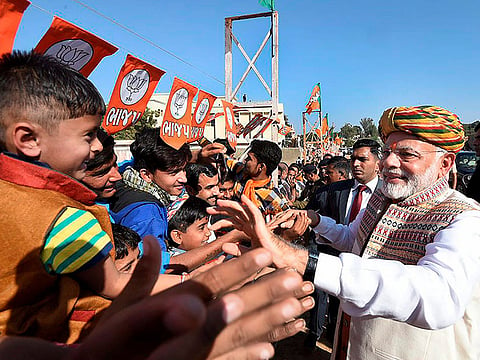RBI given ammunition to hold rates as India economy recovers
GDP in Asia’s third-largest economy expanded 6.3% in July to September from a year earlier

Mumbai/New Delhi: India’s economic growth bounced back from a three-year low, giving the central bank enough ammunition to keep interest rates on hold until December 6 amid an uptick in inflationary pressures.
Gross domestic product (GDP) in Asia’s third-largest economy expanded 6.3 per cent in July to September from a year earlier, the Statistics Ministry said in a statement in New Delhi on Thursday. That’s slower than the 6.4 per cent median estimate in a Bloomberg survey of 51 economists but faster than 5.7 per cent in the previous quarter. Gross value added (GVA), a key input of GDP tracked by the central bank, rose 6.1 per cent compared with an estimated 6.2 per cent gain.
It comes as good news for Prime Minister Narendra Modi who is facing elections in his home state of Gujarat on December 18. He has been grappling with slowing growth in the past five quarters, with the economy dragged down by subdued private investments, an unprecedented cash ban imposed last year and the introduction of a countrywide consumption tax in July.
“After five quarters we are seeing a reversal — it is very encouraging,” TCA Anant, the government’s chief statistician, told a press conference in New Delhi. He added the manufacturing sector had led the recovery as the impact of the new goods and services tax began to wane. The tax had hit entire supply chains with costs for businesses jumping, hurting sentiment.
Data showed manufacturing GVA rose 7 per cent in July-September from a year earlier, while trade, hotel and similar services rose 9.9 per cent.
Thursday’s data underlined that a nascent recovery is taking place and expectations are building that private investments will pick up next year after a landmark proposal to recapitalise struggling state-run banks. That may unclog bank credit to industry and lead to higher investment growth.
Encouraging Trend
“Looks like India [is] turning a corner,” said Devendra Pant, chief economist at India Ratings & Research.
“Although we believe there is some effect of the low base of last year’s second quarter, the growth trend in core GVA — that’s excluding state and farms’ spending — is very encouraging. There seems to be some restocking after GST and manufacturing is doing relatively well. This trend needs to be nurtured.”
India’s trade was a drag on the economy in the July to September quarter, with exports lagging. That prompted one of Modi’s key advisers to pile pressure on the central bank, calling for it to weaken the rupee and boost exports. “It cannot say it won’t interfere in the money market,” Rajiv Kumar, vice-chairman of Niti Aayog, told news channel Zee Business. “Reserve Bank of India has to arrest the strength in the rupee.”
RBI On Hold
An acceleration in growth is expected to prompt RBI Governor Urjit Patel to be more hawkish in next week’s rate review. The benchmark rate is at its lowest in seven years, while consumer price inflation has surged to a seven-month high, inching toward the central bank’s medium-term target range of 4 per cent.
“The figures confirm my view that recovery is under way,” said Priyanka Kishore, lead Asia analyst at Oxford Economics. “And this will gather momentum next year, as the GST disruptions completely fade, pushing growth above 7 per cent in 2018.”
Along with expectations that inflation will rise given the hardening in global crude oil prices, there are growing concerns the government may have to borrow more to plug any fiscal slippage due to slowing revenues. This has driven government bond yields higher in the past few months.
“Today’s data points rule out any policy rate reduction in December,” said Rupa Rege Nitsure, chief economist at L & T Finance Holdings Ltd. “The RBI will be duly worried about worsening fiscal position and hardening of crude oil and other mineral prices. However, they will not raise the rates soon as overall investment sentiment is still weak.”
Bloomberg Economics analyst Abhishek Gupta, however, says unless the RBI eases policy soon, investments are unlikely to pick up.
“On [the] one hand we have structural reforms, which are pointing to potential growth, and on the other, RBI’s tight monetary policy is holding back consumption and investment,” Gupta said. “We expect the RBI to cut rates in December and switch to an accommodative stance.”
Sign up for the Daily Briefing
Get the latest news and updates straight to your inbox



